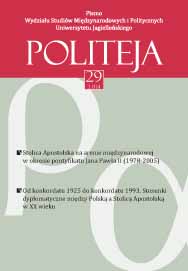Stolica Apostolska i główne problemy Narodów Zjednoczonych w okresie pontyfikatu Jana Pawła II
The Holy See and the main problems of the United Nations during the course of John Paul II’s pontificate
Author(s): Celestino MiglioreSubject(s): Politics / Political Sciences
Published by: KSIĘGARNIA AKADEMICKA Sp. z o.o.
Keywords: the Holy See; international relations; UN; John Paul II; papal teaching; human right
Summary/Abstract: The subject of the Holy See and the problems of the United Nations during the course of John Paul II’s pontificate is quite broad. It involves the period of twenty years which were rich in many events and political and social changes around the whole world. In this period the Holy See maintained its presence in the international community with the status of an observer at the forum of the UN. The diplomatic representation of the Holy See in the UN is based on the social teaching of the Church. John Paul II conceived of this teaching as a great system of concentric circles: a system whose first element is the human person and the final one – the globalized world. Due to this fact, the Catholic social teaching elaborated the concept of the principle of auxiliarity as an antidote for the period of dictatorships and regimes. The other foundation of human safety is the principle of solidarity. This principle was a peculiar feature of John Paul II who lived thirty years of his life in a country ruled by a communist regime. He was chosen as the pope in an extraordinary moment of history when international security was a much‑discussed subject. The UN and the international community saw the foundations of this security in the principle of collaboration and non‑interference, and John Paul II contributed to the elaboration of this concept by emphasizing the security of the individual and of the society. In 1969 the Vatican accepted an invitation from the countries of the Warsaw Pact to take part in the Helsinki Conference. The main concept of this conference was straightforward – security consists in the balance of power. The Holy See had a different concept of security, one that emphasized instead the common good of the community, the community to which the usage of force always brings destruction. These activities later influenced humanitarian actions, vigorously supported by the Vatican. John Paul II’s contribution to the contemplation of human rights is immense. He was true to his belief about the existence of such values and rules that are not negotiable. Their range and applicability cannot depend upon the will of the majority or pressure groups. The Holy See maintains clear and precise concept of the human person who may never be divorced from transcendence – from God. According to John Paul II and the Vatican the human person was and continues to be the point of reference expressed in views and actions, visible in diplomacy. The clear concept of man is maintained in order to facilitate an answer to the question where we come from and where we are headed.
Journal: Politeja - Pismo Wydziału Studiów Międzynarodowych i Politycznych Uniwersytetu Jagiellońskiego
- Issue Year: 11/2014
- Issue No: 29
- Page Range: 55-60
- Page Count: 6
- Language: Polish

